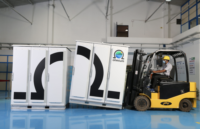In a move to reduce carbon emissions in the industrial sector, the U.S. Dept. of Energy has selected 33 projects to share as much as $6 billion to take steps to tackle the carbon levels in what it calls "difficult to decarbonize" sectors, such as cement and concrete, and iron and steel.
In announcing the winning projects on March 25, Energy Secretary Jennifer Granholm said the program represents “the largest investment in industrial decarbonization in the history of the United States.”
DOE said the projects, which involve building new facilities or upgrading existing ones, will reduce the equivalent of more than 14 million metric tons of carbon-dioxide-equivalent emissions per year.
The Inflation Reduction Act, also called the Climate Act, provides $5.47 billion of the federal total; the Infrastructure Investment and Jobs Act will fund the other $489 million.
When private sector financing is added, DOE estimates the projects' total funding is more than $20 billion.
In Demand
The agency did not release funding immediately. Sponsors of selected projects next will begin negotiations with DOE to examine budgeting and other aspects of their plans.
Interest in the grants was high. DOE said it reviewed 411 “concept papers," which requested a total of more than $60 billion in federal funds.
Seven of the 33 projects are in chemicals and refining sectors, six are in cement and concrete and another six are iron and steel production facilities. Also selected were five projects in aluminum and other metals; three in food and beverage; three in the glass industry; two in project-heat; and one in pulp and paper.
Denmark-based firm Orsted, known in the U.S. for offshore wind energy development, is set to gain $100 million for a Texas Gulf Coast project that would manufacture up to 300,000 metric tons per year of "e-methanol," which it said is made from green hydrogen produced from new onshore wind and solar power combined with captured carbon dioxide. The product would be used for marine and aviation fuels and chemicals, now produced using fossil fuel, the firm added.
Of the winners, five projects received the largest allocation, a maximum of $500 million.
Two potential awardees at that grant level are in the cement and concrete sectors:
Heidelberg Materials U.S. Inc. was picked for a cement plant decarbonization project in Mitchell, Ind. The company said the project would "capture, treat and prepare for storage or use approximately two million tons of CO2 per year."
"This substantial federal funding will help create the first full-scale deployment of carbon capture and storage on a cement plant in the U.S.," said Chris Ward, Heidelberg Materials North America president and CEO, in a statement,
The National Cement Co. of California Inc. was selected for its planned net-zero cement plant in Lebec, Calif.
Two others chosen to negotiate for $500-million grants are in the iron and steel sector: SSAB Americas––which proposed a hydrogen-fueled, zero-emissions steel-making project in Perry County, Miss., and a possible expansion of its existing facility in Montpelier, Iowa, that would include greater use of renewable energy. The company is the U.S. unit of Swedish steel company SSAB.
"We see a great interest in sustainable products from the market and this project offers a critical opportunity to solidify a first-mover advantage for the U.S. industry,” Chuck Schmitt, president of SSAB Americas, said in a statement.
Aluminum Sector Boost
Also on the $500-million list was Cleveland-Cliffs Steel Corp. for a hydrogen-ready, direct reduced iron plant and electric melting furnace installation in Middletown, Ohio. The company said its plans call for replacing an existing blast furnace at its Midddletown Works with a hydrogen-ready, direct reduced iron plant and two 120-MW electric melting furnaces. Those furnaces would "feed molten iron to the existing infrastructure already on site," it added.
The company also said the project would create 1,200 building trades jobs at peak construction.
The other potential $500-million awardee is a proposal from Chicago-based Century Aluminum Co. for a "green" aluminum smelter that would be "a tremendous win for the domestic primary aluminum industry and the broader U.S. economy...." company CEO Jesse Gary said in a statement.
With the funding, Century plans to build what it says is the first new U.S. primary aluminum smelter in 45 years that, when completed, would double the size of the current U.S. primary aluminum industry.
The firm expects to build the smelter at a site within the Ohio River-Mississippi River basins that it says would create more than 5,500 construction jobs.







Post a comment to this article
Report Abusive Comment